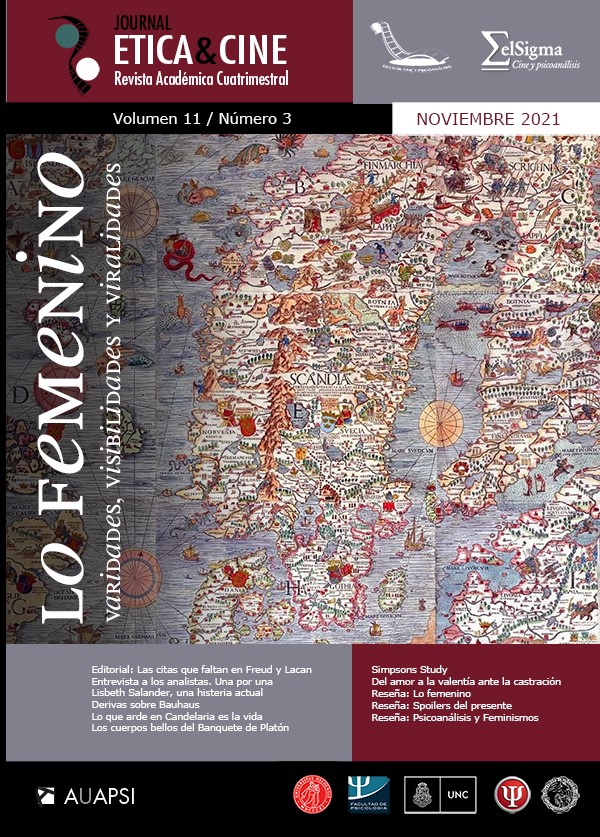Kaleidoscopic Symposium: a multifaceted look at the beautiful bodies from Plato’s Banquet
DOI:
https://doi.org/10.31056/2250.5415.v11.n3.35929Keywords:
Plato, Symposium, body, sexual desire, ethics, happinessAbstract
We will focus this work on the Platonic treatment of the body at the Symposium, under a particular approach: to consider the dialogic dynamics of this text in the manner of a "kaleidoscope" through which Plato presents us with images, elaborates them, complicates them and transforms them. We will attend in particular to the first four speeches, showing that already from the beginning there is in the dialogue a strong conceptual construction and a positive vision of the body, before the praise of Socrates. After this optical experience through the praise of Phaedrus, Pausanias, Eriximachus and Aristophanes, we will analyze the link between the sphere of corporeality and (1) sexual desire, (2) ethics and (3) happiness. We will conclude that in this dialogue Plato elaborates an anthropological model in which the role of the body is undoubtedly present for the philosophical search. Finally, we will weave a counterpoint with the film Il Banchetto di Platone by Marco Ferreri (1989), which recounts the meeting in the house of Agaton following the Platonic text almost to the letter. We will contrast our thesis with certain scenic decisions of the film, according to which the body is devalued to the darkest sphere of the purely sexual detached from the philosophical character. In the light of this counterpoint, we will return to the film, since there the corporeal is imposed as a clear protagonist and, although attached to the traditional hermeneutics of dialogue, it also opens the possibility of a critical reflection on the role that the body can have in philosophical action.
References
Boeri, M.D. (2016). Éros y synousía en el Simposio, en M. Tulli & M. Erler (Eds.), Plato in Symposium. Selected Papers from the Tenth Symposium Platonicum (pp. 362-370). Akademia Verlag.
Broadie, S. (2001). Soul and Body in Plato and Descartes en Proceedings of the Aristotelian Society. New Series, 101, 295-308.
Bury, R. G. (1932). The Symposium of Plato, with Introduction, critical Notes and Commentary. Heffer & Son.
Casertano, G. (1997). Il (in) nome di Eros. Una lettura del discorso di Diotima nel Simposio platonico. Elenchos, XVIII, 277-310.
Chen, L. C. H. (1983). Knowledge of Beauty in Plato’s Symposium. New Series, 33(1), 66-74. Cambridge University Press.
Cornford, F. M. (1974). La doctrina del éros en el Banquete de Platón (1974), en La filosofía no escrita. Editorial Ariel.
Dover, K. (1980). Plato. Symposium, edition with introduction and commentary. Cambridge.
Ferreri, M. (director). (1988). Banchetto di Platone [película]. FR3, La Sept, FIT Production, Gruppo Bema.
Fierro, M. A. (2019). Amor carnal, amor platónico en el Banquete. Estud.filos, (59), 189-219.
Fierro, M. A. (2001). Narrar el verdadero amor. El sentido de la estructura narrativa en el Banquete de Platón, en V. Juliá (ed.), Los antiguos griegos y su lengua (pp. 23-38). Biblos.
Ludueña, E. (2015). Platón, Banquete. Traducción, introducción y notas. Colihue.
Mársico, C. (2009). Platón, Banquete. Miluno.
Peixoto, M.C.D. (2012). Corpo, anima, visibile, invisibile nel Simposio platonico, en Jr. Borges de Araujo y G. Cornelli, Il Simposio di Platone: un banchetto di interpretazioni (pp. 159-179). Lofredo Editore.
Reale, G. (2010). La concepción del hombre, en G. Reale y D. Antiseri, Historia del Pensamiento Filosófico y Científico. Tomo I. Antigüedad y Edad Media. Herder.
Rowe, C.J. (1998). Plato. Symposium, edited with an Introduction, Translation and Commentary. Aris & Phillips Classical Texts.
Soares, L. (2013). La significación ética de la mímesis poética en la República de Platón y su influencia en la estética de Gadamer y Badiou. Cuadernos de Filosofía, 60, 27-41.
Vernant, J.P. (2001). El individuo, la muerte y el amor en la Antigua Grecia. Paidós.
Downloads
Published
Issue
Section
License
Copyright (c) 2021 Ética y Cine Journal

This work is licensed under a Creative Commons Attribution-ShareAlike 4.0 International License.
Los autores que publiquen en Ética y Cine Journal aceptan las siguientes condiciones:
Los autores/as conservan los derechos de autor © y permiten la publicación a Ética y Cine Journal, bajo licencia CC BY-SA / Reconocimiento - Reconocimiento-CompartirIgual 4.0 Internacional. La adopción de esta licencia permite copiar, redistribuir, comunicar públicamente la obra, reconociendo los créditos de la misma, y construir sobre el material publicado, debiendo otorgar el crédito apropiado a través de un enlace a la licencia e indicando si se realizaron cambios.

Este obra está bajo una licencia de Creative Commons Reconocimiento-CompartirIgual 4.0 Internacional.




